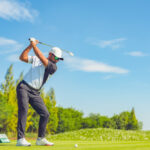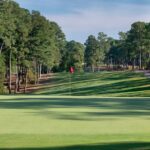Golfer’s elbow, medically known as medial epicondylitis, is a condition that causes pain and inflammation in the tendons that connect the forearm to the elbow. The pain typically occurs on the inside of the elbow and can extend along the forearm. It’s common among golfers and those who engage in repetitive wrist and arm motions. Here’s a guide on how to manage and potentially alleviate the symptoms of golfer’s elbow.
Understanding Golfer’s Elbow
Golfer’s elbow is caused by overuse of the muscles in the forearm that allow you to grip, rotate your arm, and flex your wrist. Repetitive flexing, gripping, or swinging can cause pulls or tiny tears in the tendons.
Symptoms
Symptoms of golfer’s elbow might include:
Pain and tenderness on the inside of the elbow, sometimes extending along the inner side of the forearm.
Stiffness in the elbow and difficulty making a fist.
Weakness in the hands and wrists.
Numbness or tingling that can radiate into the fingers.
Initial Steps for Treatment
Rest and Ice: The first step in treating golfer’s elbow is to rest the affected arm and avoid activities that exacerbate the pain. Applying ice to the elbow for 15-20 minutes several times a day can help reduce swelling and pain.
Compression and Elevation: Using a bandage or a compression sleeve can help reduce swelling and pain. When resting, try to elevate the arm to decrease swelling.
Medical Treatments
Over-the-Counter Pain Relief: Nonsteroidal anti-inflammatory drugs (NSAIDs), like ibuprofen or aspirin, can help reduce pain and swelling.
Physical Therapy: A physical therapist can teach you exercises to gradually stretch and strengthen the muscles and tendons in and around the elbow.
Bracing: Wearing a brace or a forearm strap can reduce stress on the injured tissue and allow it to heal.
Injections: In severe cases, your doctor might recommend steroid or platelet-rich plasma (PRP) injections to reduce inflammation and promote healing.
Preventive Measures
Strengthening Exercises: Engage in exercises that strengthen the forearm muscles. A physical therapist can recommend appropriate exercises that do not overstrain the elbow.
Proper Technique: Ensure proper form and technique in sports or activities that use the elbow and forearm extensively.
Consider taking lessons from a professional to reduce the risk of injury.
Equipment Check: Use equipment that is appropriate for your level of strength and technique. For golfers, this might mean checking the grip size and the weight of the clubs.
Warm-Up: Always warm up before beginning a sport or activity that involves the arms.
Alternative Treatments
Acupuncture and Massage: Some people find relief from acupuncture or massage therapies, which can help reduce muscle tension and pain.
Nutritional Supplements: Although evidence is limited, some believe that supplements like omega-3 fatty acids, turmeric, and ginger may help reduce inflammation.
If symptoms of golfer’s elbow persist despite home treatment, it is important to consult a healthcare provider. They can offer additional treatments or investigate other possible causes of your symptoms. Remember, early intervention is the key to a quick and successful recovery.
Advanced Treatment Options
If conventional treatments for golfer’s elbow do not provide sufficient relief, there are more advanced options available that can be discussed with a healthcare provider.
Corticosteroid Injections
Corticosteroid injections can be considered for severe cases of golfer’s elbow when other treatments have failed. These injections can provide temporary relief from pain and inflammation. However, their effects diminish over time and repeated use can weaken tendons, so they are typically used sparingly.
Surgery
Surgery might be an option if the pain is severe, persistent, and not relieved by other treatments. The procedure typically involves removing damaged tissue from the tendon, releasing the tendon, and reattaching it. Surgery is usually a last resort and comes with typical surgical risks and the need for post-operative rehabilitation.
Rehabilitation and Recovery
Post-Treatment Care
Following any treatment, whether it’s conservative management or surgery, proper rehabilitation is crucial. A structured rehabilitation program can help restore the elbow’s strength and flexibility. This typically involves:
Gradual Stretching: Starting with gentle stretches and progressively increasing intensity.
Strengthening Exercises: Including specific exercises to strengthen the muscles of the forearm, wrist, and shoulder to support the elbow.
Gradual Return to Activity: A careful, step-by-step approach to return to previous levels of activity without overloading the healing tissues.
Long-Term Management
To manage golfer’s elbow in the long term and prevent recurrence, consider the following strategies:
Regular Physical Activity
Engage in regular exercise that includes a balanced strength training program, which incorporates the upper body, lower body, and core. This approach helps ensure that no single muscle group is overworked.
Ergonomic Adjustments
If repetitive tasks at work or during hobbies contribute to golfer’s elbow, ergonomic adjustments may help. This could involve arranging workspaces to encourage better posture, using ergonomic tools, or taking regular breaks to stretch and rest the muscles used in repetitive motions.
Monitor Symptoms
Keep track of any symptoms and respond quickly to changes. Early intervention can prevent a minor flare-up from becoming a long-term problem.
Coping and Support
Living with golfer’s elbow can be challenging, especially if it affects daily activities or sleep patterns. Support from friends, family, and possibly a professional therapist or counselor can be beneficial. Joining support groups where members share strategies and experiences can also provide emotional support and practical advice.
Golfer’s elbow can be a frustrating and painful condition, but with the right approach, it can be managed effectively.
Always consult with a healthcare professional for a diagnosis and appropriate treatment plan tailored to your specific condition. Remember, each person’s recovery will vary, and it’s important to adjust any treatment plan based on personal progress and feedback from medical professionals.
Lifestyle Adjustments for Better Outcomes
Making lifestyle adjustments can play a significant role in both the recovery and prevention of golfer’s elbow. Here are some additional considerations to help manage the condition more effectively:
Stress Management
Stress can exacerbate physical conditions and lead to tension in the muscles, including those around the elbow.
Techniques such as mindfulness, meditation, and deep-breathing exercises can help manage stress levels, potentially reducing the risk of muscle strain.
Diet and Nutrition
A well-balanced diet supports overall health and aids in the recovery and repair of tissues. Eating foods rich in antioxidants, proteins, and omega-3 fatty acids can help reduce inflammation and promote healing. Staying hydrated is also crucial as water plays a key role in maintaining the elasticity and lubrication of tissues.
Proper Sleep
Adequate sleep is essential for healing, as the body repairs itself during sleep. Ensuring a good night’s sleep can improve overall recovery times and effectiveness. Creating a comfortable sleeping environment and maintaining a regular sleep schedule can aid in better sleep quality.
Stay Informed
Understanding the condition thoroughly, including its causes, symptoms, and treatments, empowers you to make informed decisions about your health. Education on golfer’s elbow can also help in recognizing early signs of recurrence, allowing for prompt treatment.
Monitoring Progress
Keeping track of your progress is crucial. This could involve:
Regular Check-ups: Regular visits to the healthcare provider can help monitor the condition and make necessary adjustments to the treatment plan.
Pain Journal: Keeping a diary of pain levels, triggers, and activities can provide valuable insights to both the patient and the healthcare provider, helping to fine-tune management strategies.
Feedback Loop: Communicating openly with your healthcare team about what works and what doesn’t allows for a more tailored approach to your care.
Seeking Professional Advice
It’s important to consult healthcare professionals who specialize in sports medicine or musculoskeletal conditions for targeted advice. These specialists can provide:
Advanced Diagnostic Tools: Sometimes, more detailed imaging tests or assessments may be needed to fully understand the condition or to plan further treatment.
Customized Rehabilitation Programs: Based on your specific condition, a physical therapist might design a personalized program that targets your needs and goals.
Alternative Therapies: Professionals may also suggest alternative therapies such as ultrasound therapy, laser treatment, or shockwave therapy, which have shown benefits in some cases.
Managing golfer’s elbow effectively requires a combination of medical treatment, preventive measures, and lifestyle changes. The key to successful management lies in early diagnosis, adherence to a structured treatment plan, and proactive long-term care. With the right approach, individuals suffering from golfer’s elbow can achieve not only pain relief but also a return to their normal activities and an improved quality of life. Remember, every individual’s response to treatment can vary, so staying patient and committed to your recovery process is vital.







